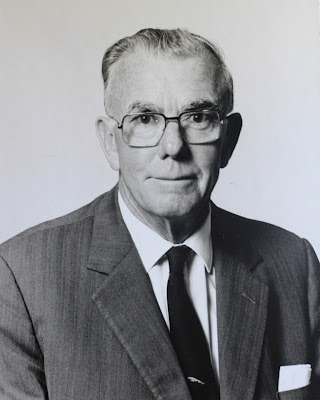
FRW (Lofty) England of Jaguar
“My most memorable character” used to be a feature in Reader’s Digest. My “most memorables” tended to be engineers or in motor racing. Some were both, like Tony Rudd of BRM, the archetypal articulate engineer. Winning world championships with BRM and becoming Colin Chapman’s trusted adviser were outstanding accomplishments. He managed to convince BRM to flatten out two of its successful V8s, put them on top of one another, gear the crankshafts together and make the H16. Articulate? Read his book, “It was fun!”, published by Haynes in 1993. Great man. Great host. Great family. Jackie Stewart’s tribute at his memorial service was a masterpiece.
FRW England was another “memorable”. I treasure a print of Terence Cuneo’s painting, Pit Stop Le Mans 1953, on which he wrote “Eric – a memento of our good relations. Lofty”. Jaguar was replete with memorable individuals in the 1960s. Sir William Lyons created a unique company culture of loyalty and respect, which included my most frequent point of contact, the press office, under Bob Berry and the irreplaceable Andrew Whyte. I have dedicated our new ebook to the memory of Andrew John Appleton Whyte. It could not have been compiled without him.

Lofty England
Frank Raymond Wilton England (1911-1995) joined as service manager at Swallow Road aged 35. At 6ft 5in “Lofty” England was an apprentice at Daimler’s London service depot in 1927, until his enthusiasm for motor racing took him as mechanic to some outstanding teams. He worked on Sir Tim Birkin’s Bentleys, Whitney Straight’s Maseratis, ERAs at Bourne Lincolnshire and Richard Seaman’s Delage. When Seaman went off to drive for Mercedes-Benz, FRWE, or Lofty, as he was known, joined Prince Bira of Siam who had two ERAs, a Delage, Delahaye and a Maserati. Impressed with how the team was run by Bira’s cousin Prince Chula, Lofty remained until March 1938, joining Alvis as service superintendent. The war took him into the Royal Air Force in which he served as a Lancaster pilot bombing Germany. Afterwards, uncertain of Alvis’s future, he got in touch with Walter Hassan, a friend from Brooklands and ERA days, securing the appointment at Jaguar. His responsibilities as service manager were cautiously understated, since they included responsibility for Jaguar’s motor racing programme. Lofty England’s rationale was that cars with works backing were expected to do well, so he carefully maintained a sub rosa affiliation with private teams and drivers. Goldie Gardner’s 1948 record car with its experimental 4-cylinder engine, Tommy Wisdom’s XK120 and William Lyons’s son-in-law Ian Appleyard’s XK 120 were prepared either by the factory or under its tutelage. While the practice was not wholly secret, it was not made public either. Recipients of advice or practical assistance understood the system. They could acknowledge Jaguar’s polite interest, but they had better not brag about how substantial it was or it would be quickly and quietly withdrawn. England’s department provided this covert support to ostensibly private XK120s at Le Mans in 1950; aluminium-bodied cars sold in the ordinary way and expected to give a good account of themselves. William Lyons ostentatiously maintained his custom of attending the TT motorcycle races in the Isle of Man, lest the firm’s interest in Le Mans was betrayed. It was a clever rehearsal for participation with a works team the following year when the C-type won. Aged 60, Lofty England succeeded Sir William Lyons as chairman and chief executive, but the upheavals of the British Leyland days were far from over and in January 1974 he announced his retirement. He moved to Austria from where he continued to take a keen interest in everything Jaguar.

Text from JAGUAR: All models since 1922 www.amazon.co.uk for Kindles and http://www.waterstones.com/waterstonesweb/products/eric+dymock/Jaguar.

Nick Scheele: Former chief executive of Jaguar, in the Lyons mould.

No comments:
Post a Comment